Puerto Madryn, Patagonia, Argentina
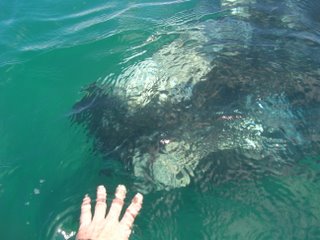
The whales were here! I got to see them! In a small boat! Up close!
It was the best whale watch of my life. I actually... touched... a whale.
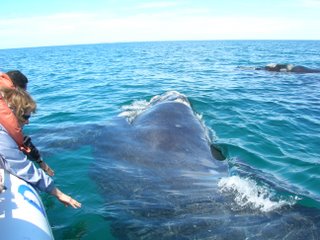 Yes! The calves came this close! Here's my friend Karen hoping to touch a curious calf.
Yes! The calves came this close! Here's my friend Karen hoping to touch a curious calf.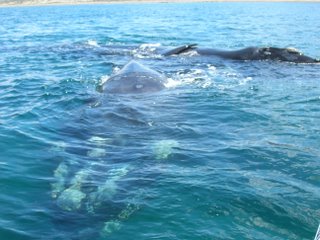 A calf swims right over on top of its mother. It's touching to see how closely in contact they stay. The twelve mother and calf pairs we saw were all near the "gate" of the bay, where the moms take the babies into deep water for the first time. One calf had a ragged wound on its back that our captain said was from an orca. All the mothers were laying low, being quiet, and staying near the boat, perhaps in an effort to evade the orcas. These were the last of the 700 or so that come to Peninsula Valdes to give birth, get pregnant, or try to get someone pregnant each austral winter. The moms are getting hungry now and it's time to leave the bay for waters near Tierra del Fuego and Antarctica, where they'll wean their babies and teach them how to skim krill from the water's surface. When we are back there on Wednesday, they may all be gone.
A calf swims right over on top of its mother. It's touching to see how closely in contact they stay. The twelve mother and calf pairs we saw were all near the "gate" of the bay, where the moms take the babies into deep water for the first time. One calf had a ragged wound on its back that our captain said was from an orca. All the mothers were laying low, being quiet, and staying near the boat, perhaps in an effort to evade the orcas. These were the last of the 700 or so that come to Peninsula Valdes to give birth, get pregnant, or try to get someone pregnant each austral winter. The moms are getting hungry now and it's time to leave the bay for waters near Tierra del Fuego and Antarctica, where they'll wean their babies and teach them how to skim krill from the water's surface. When we are back there on Wednesday, they may all be gone. A calf swims right under our boat. This is its tail. The water was so shallow and clear we could see their shadows on the bottom. I wanted to jump right in!
A calf swims right under our boat. This is its tail. The water was so shallow and clear we could see their shadows on the bottom. I wanted to jump right in!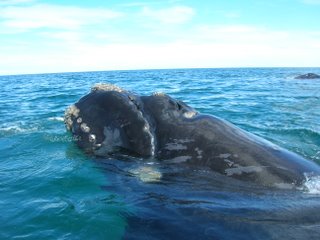 The highly arched outline of the mouth is characteristic of right whales, as are the white areas, called callosities. The animal's eye is below the white patch that's near the corner of the mouth. Callosities are thickened, cracked areas of skin that in older animals become encrusted with cyamids, or whale lice, and barnacles. The young calves have very few cyamids yet.
The highly arched outline of the mouth is characteristic of right whales, as are the white areas, called callosities. The animal's eye is below the white patch that's near the corner of the mouth. Callosities are thickened, cracked areas of skin that in older animals become encrusted with cyamids, or whale lice, and barnacles. The young calves have very few cyamids yet.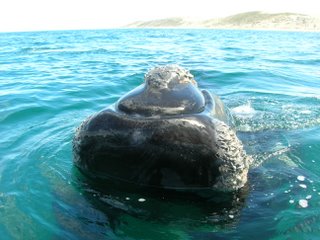 But they do have whiskers! Click on the picture to enlarge and see the bristles all over this calf's chin. This is the one I touched. Fernando, our driver and guide, told us they like music, so my friend Chris who's also an opera composer whistled an improvisation that might have brought the whales closer. The mom came too, but not as close. Fernando told us we could put our hands in the water, that they are attracted to the motion, but not to splash at them because that repels them. I waved my hand slowly and gracefully like a flipper, and this youngster came right up to us! Three of us were in the right spot to touch the lower lip. I didn't want to upset it by rubbing its sensitive bristles but it was hard to avoid. To my surprise the skin was not only silky smooth, which I expected, but also soft and yielding. I expected it to be more firm. The bristles were softer than I'd think too. With three of us rubbing its mouth, the calf soon jerked its head away. All around the boat the smiles were wider than the sky.
But they do have whiskers! Click on the picture to enlarge and see the bristles all over this calf's chin. This is the one I touched. Fernando, our driver and guide, told us they like music, so my friend Chris who's also an opera composer whistled an improvisation that might have brought the whales closer. The mom came too, but not as close. Fernando told us we could put our hands in the water, that they are attracted to the motion, but not to splash at them because that repels them. I waved my hand slowly and gracefully like a flipper, and this youngster came right up to us! Three of us were in the right spot to touch the lower lip. I didn't want to upset it by rubbing its sensitive bristles but it was hard to avoid. To my surprise the skin was not only silky smooth, which I expected, but also soft and yielding. I expected it to be more firm. The bristles were softer than I'd think too. With three of us rubbing its mouth, the calf soon jerked its head away. All around the boat the smiles were wider than the sky.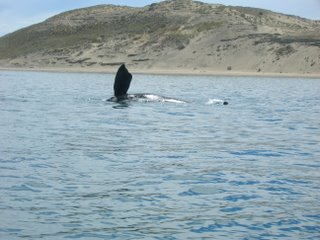 Another calf that Fernando knows well, called Demosthenes, waves "Bye-bye" as we drive away. He didn't let us touch him but spent a lot of time lolling and rolling over just barely out of reach. Twice he rolled onto his side to look at us with his great eye out of the water, and several times he swam right under us. He's been known to push boats gently from behind or even to nudge from below. He likes the boats so much that our driver actually had to lead him back to his mother. Even so, he wouldn't go all the way to her -- he stopped behind us and started doing pectoral flipper slaps like this, as if to protest!
Another calf that Fernando knows well, called Demosthenes, waves "Bye-bye" as we drive away. He didn't let us touch him but spent a lot of time lolling and rolling over just barely out of reach. Twice he rolled onto his side to look at us with his great eye out of the water, and several times he swam right under us. He's been known to push boats gently from behind or even to nudge from below. He likes the boats so much that our driver actually had to lead him back to his mother. Even so, he wouldn't go all the way to her -- he stopped behind us and started doing pectoral flipper slaps like this, as if to protest!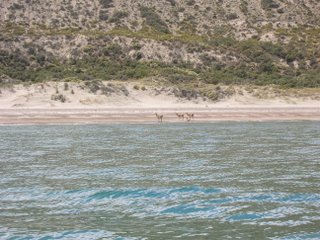 Wild guanacos at the shore line. Notice the calf second from the right. They are commonly seen around Puerto Madryn and are protected on the Peninsula Valdes.
Wild guanacos at the shore line. Notice the calf second from the right. They are commonly seen around Puerto Madryn and are protected on the Peninsula Valdes.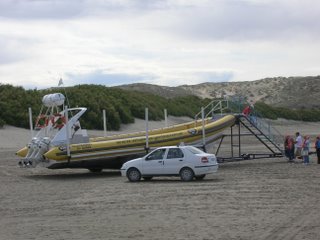 We rode in an awesome hard-bottomed inflatable like this. The solid sand beach is very wide and the water shallow, so they load passengers on land and then push the trailer into the water with old farm tractors. They get an extra ten years out of the tractors once they're too worn out for hard farm work. The boats were very comfortable, clean, and well-powered. They're also just a little bigger than the fiberglass launch I drove at the Smithsonian field station in Belize. Fun.
We rode in an awesome hard-bottomed inflatable like this. The solid sand beach is very wide and the water shallow, so they load passengers on land and then push the trailer into the water with old farm tractors. They get an extra ten years out of the tractors once they're too worn out for hard farm work. The boats were very comfortable, clean, and well-powered. They're also just a little bigger than the fiberglass launch I drove at the Smithsonian field station in Belize. Fun.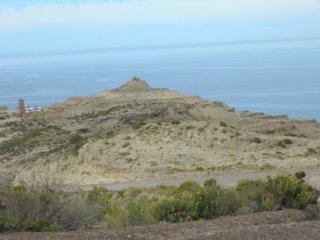 Puerto Piramides gets its name from these sandstone and unlithified sand strata formations. Below this point some sea lions were pupping and many big kelp gulls were feeding their huge, fuzzy gray chicks.
Puerto Piramides gets its name from these sandstone and unlithified sand strata formations. Below this point some sea lions were pupping and many big kelp gulls were feeding their huge, fuzzy gray chicks.

No comments:
Post a Comment